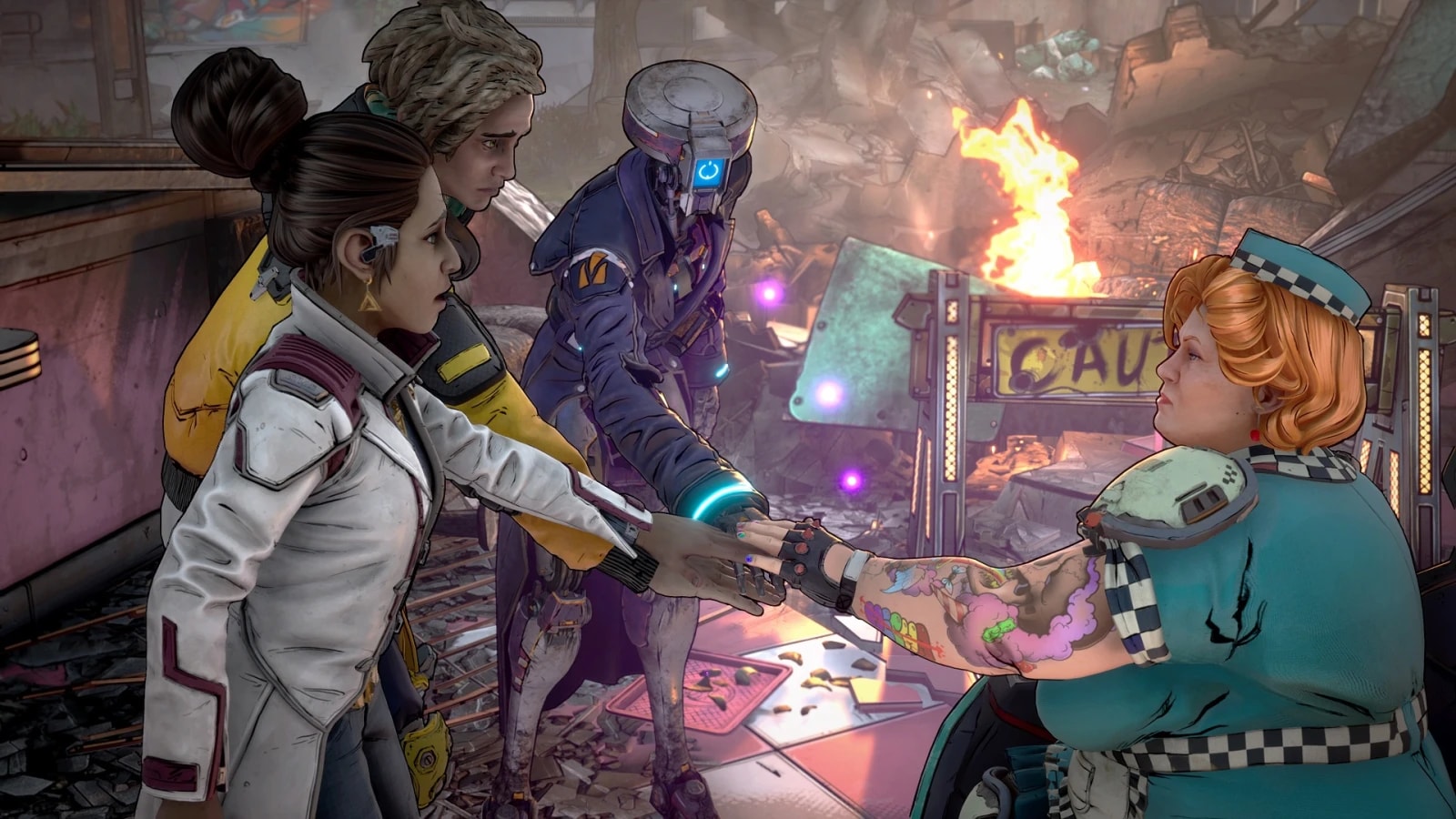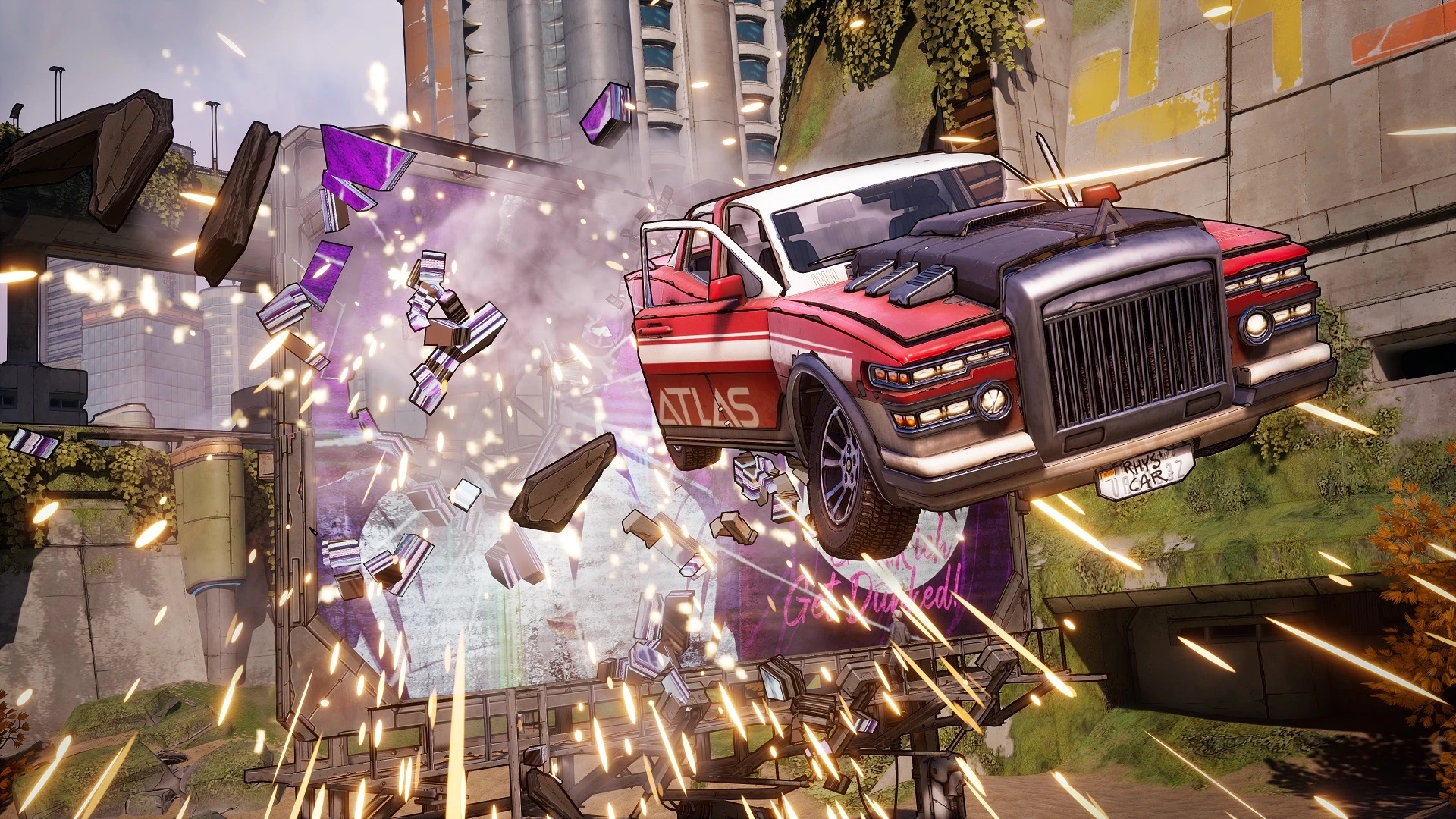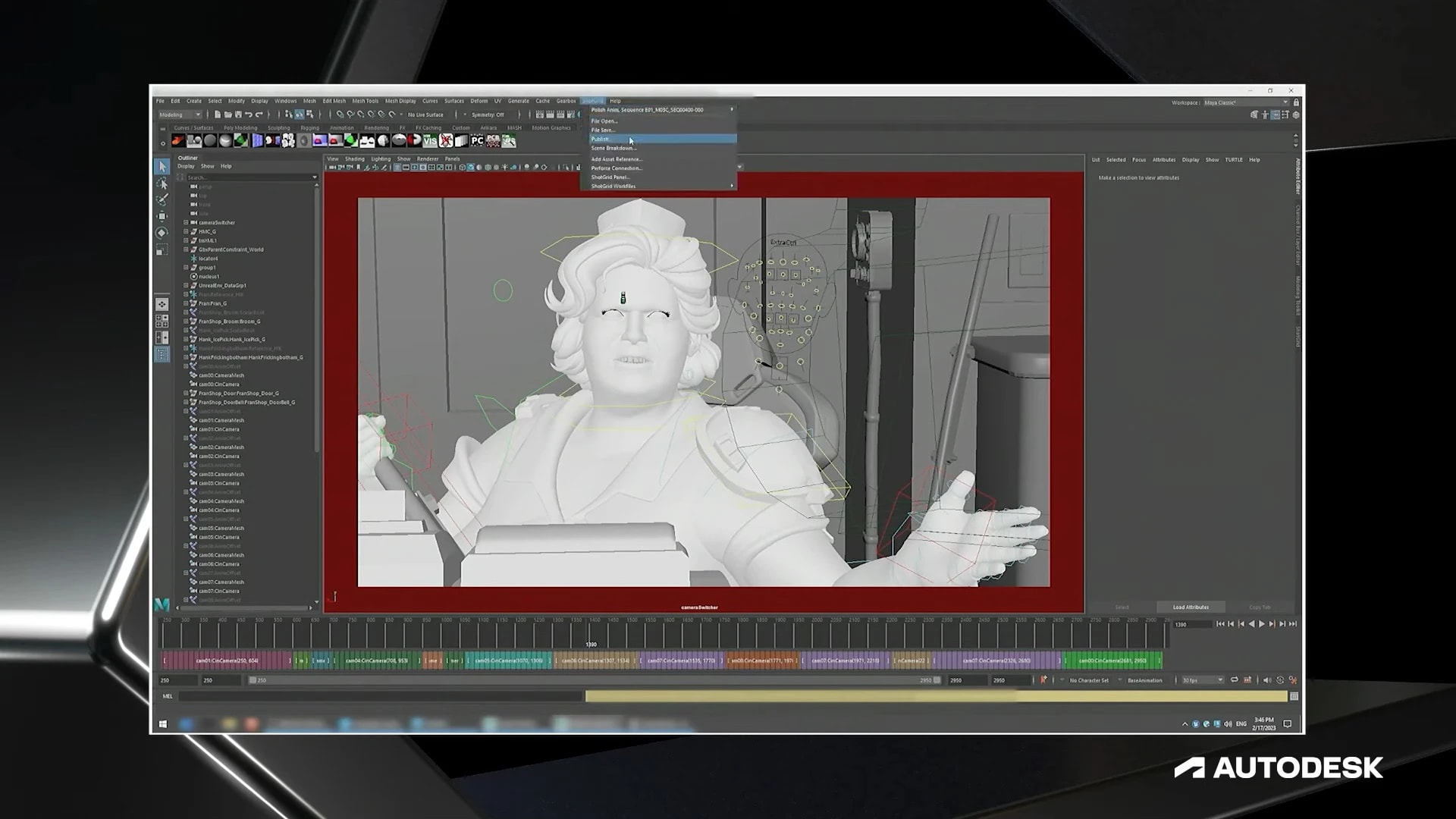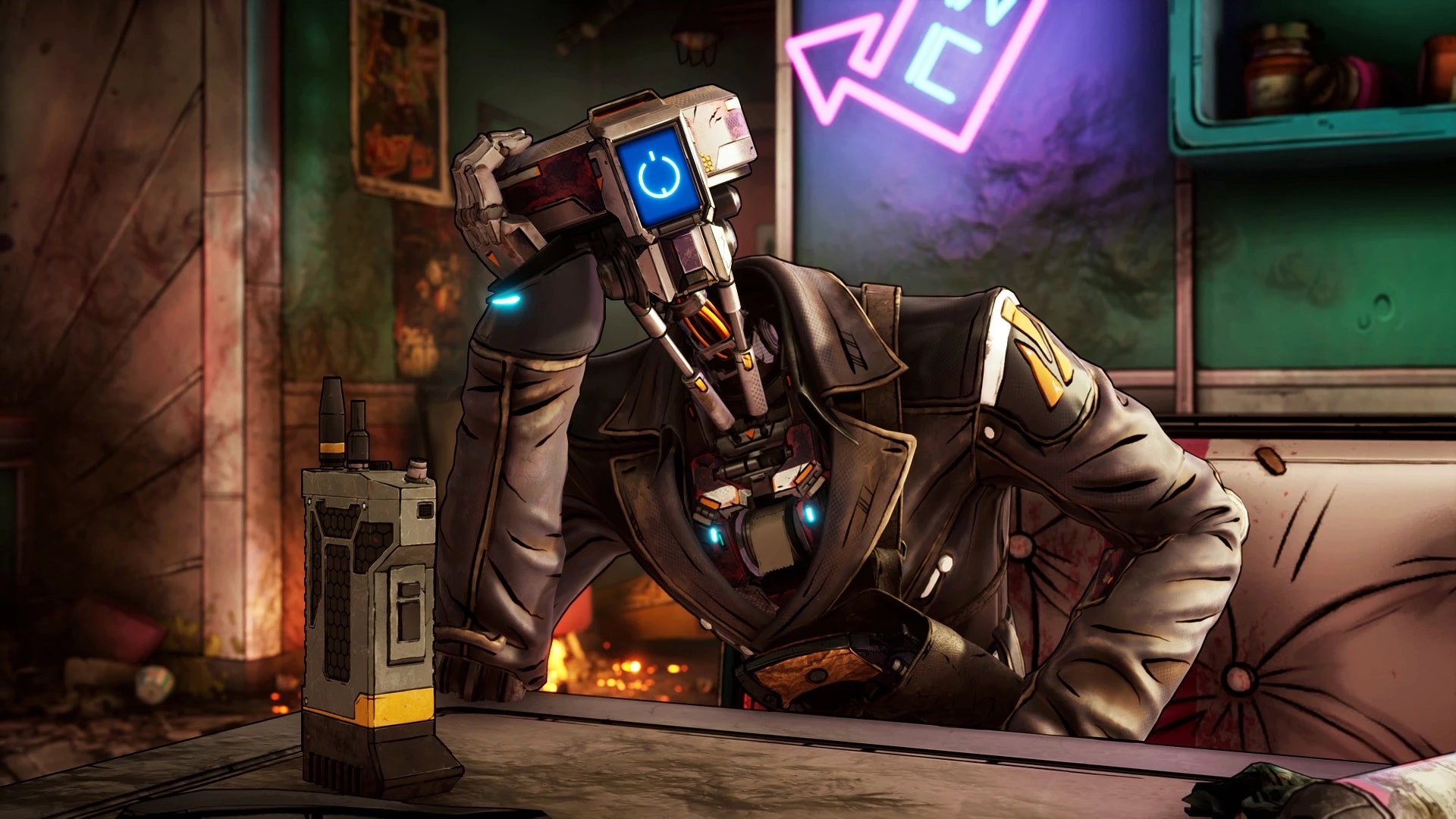& Construction

Integrated BIM tools, including Revit, AutoCAD, and Civil 3D
& Manufacturing

Professional CAD/CAM tools built on Inventor and AutoCAD
& Entertainment

Entertainment content creation tools, including 3ds Max and Maya
Using a custom-built automated cinematic pipeline, game developer Gearbox delivered its New Tales from the Borderlands with astounding speed and quality. Courtesy of Gearbox Software/2K Games.
For its recent game, New Tales from the Borderlands, Gearbox Software had just two years to create 12 hours of cinematic gameplay–a job that traditionally took four years to produce three hours.
By automating logistical tasks, Gearbox drastically cut development and review time, reduced human error, and improved work-life satisfaction for its creative team members.
With a custom-built animation pipeline using Autodesk Maya and Flow Production Tracking, artists are now able to spend 50% more time on creative work instead of on logistics.
The line between modern gaming and cinema is razor-thin. Thanks to compelling storytelling, sophisticated graphics, and cutting-edge 3D animation, video games today look and feel like they belong in films. Even better, great video games offer something films never can: total immersion. When you watch a film, you’ll always feel like you’re in the audience. But when you play a video game, you can feel like you’re actually in it.
That’s certainly the case with Gearbox Software’s New Tales from the Borderlands. Released in 2022, the latest instalment of the popular Borderlands franchise tells the story of three civilians trying to live their lives in war-torn Meridian City. There’s well-meaning scientist Anu, her hustler brother Octavio, and embattled business owner Fran, each of whom must battle monsters and criminals in pursuit of their hopes and dreams.
Players control the decisions the characters make in the explosive cinematic adventure New Tales from the Borderlands. Courtesy of Gearbox Software/2K Games.
However, what makes New Tales from the Borderlands so remarkable isn’t just the characters or their stories –it’s how the game is played. Unlike traditional games where players follow a predetermined sequence of events from start to finish, players in New Tales from the Borderlands control what decisions the characters make and, as a result, what their fates will be.
According to Gearbox, every choice that players make can affect how the story unfolds, often in unexpected ways, with deep, immersive story scenes, mini-games, and free-walk sequences. By giving players the power to make choices that shape the game’s characters, environment, and events, New Tales from the Borderlands turns them into creators.
But what about the game’s actual creators, the 3D artists and animators who brought the game to life? To create such an immersive and interactive game, they had to produce a massive amount of high-quality content –and to satisfy market demand for a new instalment in the Borderlands series, they had to produce it very quickly. A team of 15 animators had just two years to produce 12 hours of cinematic gameplay, according to Marion Guignolle, lead technical design animator at Gearbox Studio Québec.
“Usually, it takes three to four years to do three hours,“ says Guignolle, who adds that there’s one reason her team was able to produce so much content so quickly: automation.
In the world of media and entertainment, there’s an ever-present need to create more, better, and faster content. To meet that need, Gearbox Studio Québec custom-built an automated cinematic animation pipeline from the ground up using Autodesk Maya and Flow Production Tracking (formerly ShotGrid).
Here’s how the pipeline functions: First, writers create a narrative script that’s translated to a storyboard with illustrations, like a comic strip. Next, the storyboard is transferred to a layout, which is an animation blocking of the storyboard in space. With the layout, actors can then position themselves correctly during a motion-capture shoot, where their movements are recorded to create scaffolding for the game’s animated characters. The data from motion capture ends up in Flow Production Tracking, which generates scenes for animators and assigns them a workload. Animators then animate scenes in Maya and export them back to Flow Production Tracking, which places them in the developers’ game engine at the right location. At each step of the way, Flow Production Tracking enables faster, easier scene and asset reviews. Because everything is integrated, if a change to a scene is made during the review process, all of the related assets will be updated accordingly, which helps save time.
The automated pipeline integrates Flow Production Tracking with Maya and other tools that artists use everyday, speeding up development time and review cycles. Courtesy of Gearbox Software/2K Games.
Automated asset management (US Site) within Flow Production Tracking and Maya is the key to the entire workflow, according to Guignolle, who says animators no longer have to spend time manually retrieving tasks and managing files. Instead, tasks and files flow automatically to and from the right person, at the right time, and with the correct reference assets already attached to them. On New Tales from the Borderlands, the first project on which Gearbox used its new pipeline, the result was serious time savings.
“Usually, animators need to create their scene, import the assets, and stuff like that,“ Guignolle says. “But in this instance, they saved at least 30 minutes to an hour a day of just manual work because we automated that through Flow Production Tracking.“
Consider a hypothetical scene featuring 12 soldiers, three with speaking roles. Traditionally, animators would have to manually name each soldier, and then assign the right audio and animation tracks to the right soldiers. That process would take up to two hours; now, Flow Production Tracking can complete those tasks in a matter of moments.
On a project like New Tales from the Borderlands, the most obvious advantage of automation is speed. But an equally important benefit is quality, according to Guignolle, who cited human error as a major concern on complex and fast-moving projects.
“We’re humans, so a lot of reasons can affect a person and make them not do their work the best that they could,“ she says. “Automation of the scenes through Flow Production Tracking reduced the time, but it also reduced errors because we had a lot of validation built in through the pipeline.“
Because Gearbox developed New Tales from the Borderlands during the COVID-19 pandemic with teams in both Québec and Vancouver, another benefit was improved collaboration. Using cloud-based Flow Production Tracking to automate workflows across users and time zones improved teamwork and communication remotely. A remote Flow Production Tracking setup tool also made the pipeline functional across a multitude of desktop environments and users.
The latest instalment in the Borderlands franchise features a host of returning and new characters, including an assassin bot with comedic aspirations. Courtesy of Gearbox Software/2K Games.
For the animators, the pipeline’s most powerful benefit is probably work-life balance, as team members can accomplish more work in fewer hours. “In the industry nowadays, quality of life can outweigh certain other aspects, including what project you’re working on or how much money you’re being paid,“ says Guignolle, who adds that Gearbox’s cinematic pipeline reinforces its company culture to attract more and better talent. “People really like Gearbox because they can easily work with their managers to request time off when they need to. They don’t have to stress.”
Meanwhile, the time they spend working is more fulfilling. Before Gearbox implemented its cinematic workflow, the company’s digital artists spent an estimated 60% of their project time on logistical tasks like file management and just 30% on creative work like animation, with the remaining 10% devoted to administrative things like email. Now, digital artists at Gearbox spend 60% of their time on creative work, 30% on logistics, and 10% on administration.
With an automated animation pipeline, digital artists are able to focus more of their time on creative work instead of on logistics. Courtesy of Gearbox Software/2K Games.
“The time they no longer spend on managing the assets for the scene they can now spend on making it,“ Guignolle says. Automation can yield the same benefits in other data-centric industries (US Site) that it does in game development. “Anything that’s data-driven is an asset, and anything that’s an asset needs automation for whatever process it needs to go through.“
Like gameplay in New Tales from the Borderlands, the outcomes you get depend on the choices you make. “In my opinion, this automation must be pertinent and intelligent,“ Guignolle says. “Don’t use automation just for the sake of using automation.“




